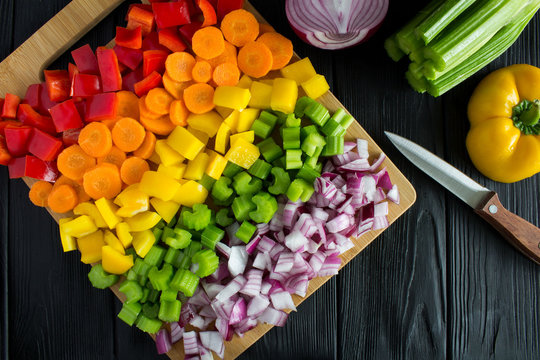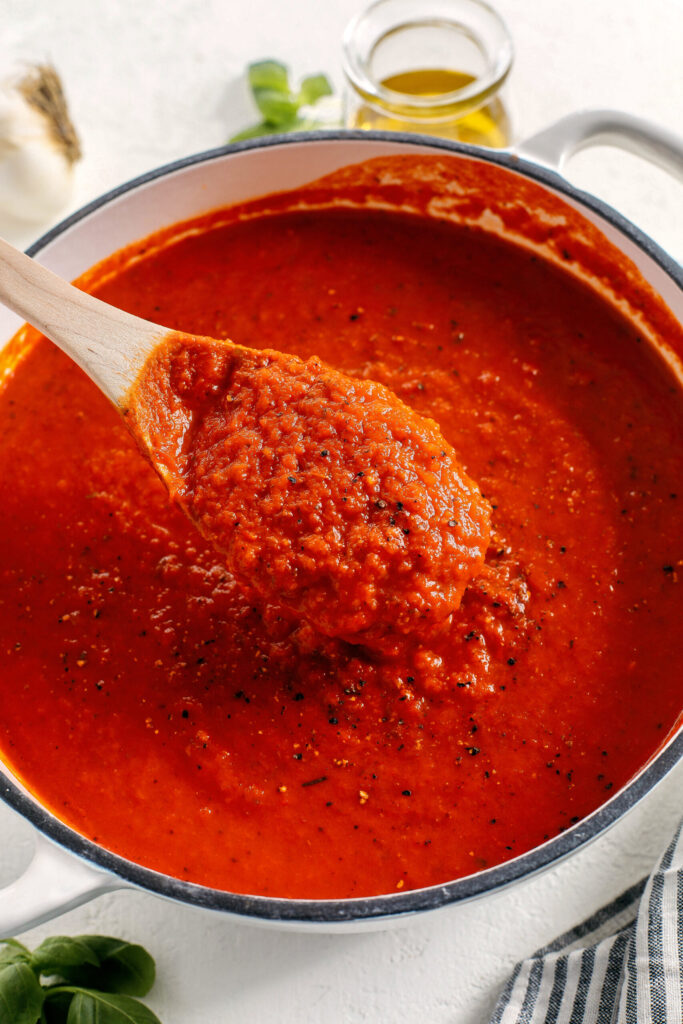
Are you tired of bland, store-bought pasta sauces that lack character? Yearning for a burst of fresh flavors to elevate your pasta dishes? Look no further! In this article, we’ll unravel the secrets behind creating a delicious vegetarian pasta sauce from scratch.
No more settling for mediocrity—our recipe promises vibrant colors, tantalizing aromas, and a symphony of taste that will leave your taste buds dancing.
Whether you’re a seasoned chef or a kitchen novice, get ready to transform simple ingredients into a culinary masterpiece. Let’s embark on this saucy adventure together!
Vegetarian pasta sauce recipe from scratch Ingredients
Fresh Vegetables:
- Tomatoes: Opt for ripe, juicy tomatoes. You can use a mix of varieties like Roma, cherry, or heirloom.
- Onions: Yellow or red onions work well. They add sweetness and depth to the sauce.
- Bell Peppers: Red, green, or yellow—choose your favourite. They contribute colour and flavour.
- Garlic: Fresh garlic cloves, minced or finely chopped, for that aromatic base.
- Carrots: Grated carrots lend natural sweetness and balanced acidity.

Fresh Herbs:
- Basil: The star herb! Fragrant basil leaves elevate the sauce.
- Oregano: Dried or fresh, oregano adds earthy notes.
- Thyme: A pinch of fresh thyme complements the other flavours.

Pantry Staples:
- Olive Oil: Extra-virgin olive oil for sautéing.
- Salt and Pepper: Essential for seasoning.
- Red Pepper Flakes: Optional for a hint of heat.
- Sugar: A touch of sweetness to balance acidity.

Preparation
Vegetable Prep:
- Tomatoes: Blanch, peel, and chop the tomatoes. Remove seeds if desired.
- Onions and Bell Peppers: Dice them finely.
- Garlic: Mince it.
- Carrots: Grate them.

Herb Prep:
- Basil: Wash and gently tear the basil leaves.
- Oregano and Thyme: If using fresh, chop them finely.
Heat the Pan:
- Heat olive oil in a saucepan over medium heat.
Sauté the Aromatics:
- Add minced garlic and diced onions. Sauté until fragrant and translucent.
Add the Vegetables:
- Toss in the diced bell peppers and grated carrots. Cook until slightly softened.
Tomatoes and Herbs:
- Add the chopped tomatoes, basil, oregano, and thyme.
- Season with salt, pepper, and a pinch of red pepper flakes.
Simmer and Blend:
- Let the sauce simmer on low heat for about 20-30 minutes.
- For a smooth sauce, blend using an immersion blender or regular blender.
And there you have it—the foundation of your homemade pasta sauce! Next, we’ll explore flavour enhancements and achieving the perfect texture.
Cooking Process
Sautéing the Aromatics:
- Heat the Pan: Begin by heating a saucepan over medium heat. Add a generous drizzle of extra-virgin olive oil.
- Garlic and Onions: Once the oil is warm, toss in the minced garlic and diced onions. Sauté them until they become fragrant and translucent. This aromatic base sets the stage for the sauce’s rich flavours.
- Bell Peppers and Carrots: Add the finely diced bell peppers and the grated carrots. These veggies contribute both colour and natural sweetness to the sauce. Cook them until they’re slightly softened.

Tomato Magic:
- Chopped Tomatoes: Now, it’s time for the star ingredient—chopped tomatoes. You can use fresh, ripe tomatoes or canned ones. The choice is yours! The tomatoes will break down as they cook, creating a luscious base for our sauce.
- Herbs: Introduce the fresh basil leaves, dried oregano, and a pinch of thyme. These herbs infuse the sauce with delightful earthiness and aroma.
- Seasoning: Season the sauce with salt, pepper, and a touch of red pepper flakes if you like a little heat.

Simmer and Blend:
- Low and Slow: Let the sauce simmer gently over low heat. Allow it to meld and develop flavours for about 20 to 30 minutes. Stir occasionally to prevent sticking.
- Texture: Depending on your preference, you can leave the sauce chunky or blend it for a smoother consistency. An immersion blender works wonders here.
Flavor Enhancements
Heat and Sweetness:
- Red Pepper Flakes: If you crave some spiciness, add a pinch of red pepper flakes. They’ll wake up your taste buds.
- A Hint of Sugar: To balance the natural acidity of tomatoes, sprinkle in a pinch of sugar. It’s a subtle touch that makes a big difference.
Now that our sauce is simmering away let’s move on to achieve the perfect texture and fine-tune the flavours. Get ready to impress your dinner guests with this homemade masterpiece!
Texture and Consistency
Smooth or Chunky:
- Smooth Sauce: If you prefer a velvety texture, use an immersion blender to puree the sauce until smooth. This works well for coating delicate pasta shapes.
- Chunky Sauce: For a rustic feel, leave the sauce as-is. The tender chunks of vegetables and herbs add character and depth.

Seasoning and Adjustments
Taste and Tweak:
- Salt and Pepper: Taste the sauce and adjust the seasoning. A pinch more salt or pepper can make a world of difference.
- Herbs and Spices: Feel free to add extra basil, oregano, or thyme if desired.
- Acidity Balance: If the sauce is too tangy, a touch more sugar can mellow it out.
Remember, cooking is an art, and these adjustments allow you to tailor the sauce to your palate. Now, let’s move on to serving suggestions and storing this delectable creation!
Serving Suggestions
Pairing with Pasta:
- Cooked Pasta: Boil your favourite pasta—whether it’s spaghetti, penne, or fusilli.
- Coating the Pasta: Toss the freshly cooked pasta in our homemade sauce. Ensure each strand is lovingly coated.
Garnishes:
- Fresh Basil Leaves: Sprinkle some torn basil leaves on top for a burst of colour and aroma.
- Grated Parmesan or Vegan Cheese: Grate some cheese over the sauced pasta. The salty richness complements the flavours.
Storage and Reheating
Storing Leftovers:
- Refrigerator: Store any leftover sauce in an airtight container in the refrigerator. It should stay fresh for up to 3-4 days.
- Freezing: For longer storage, freeze the sauce in portions. Thaw it in the refrigerator before reheating.
Reheating:
- Stovetop: Heat the sauce gently on the stovetop, stirring occasionally. Add a splash of water if needed to maintain the desired consistency.
- Microwave: Zap individual portions in the microwave, stirring midway.
And there you have it—a delightful vegetarian pasta sauce that’s ready to elevate your pasta nights. Bon appétit!

Final Analysis
In the realm of homemade cooking, few pleasures rival the satisfaction of crafting your own vegetarian pasta sauce recipe from scratch. As the aroma of simmering tomatoes and fresh herbs fills your kitchen, you’ll know you’re creating something special—a sauce that transcends mere sustenance. Remember, this recipe isn’t just about ingredients and techniques; it’s about infusing love and creativity into every stir of the spoon.
Whether you’re sharing it with loved ones or savoring it solo, this sauce carries the essence of your culinary passion. So go ahead, ladle it generously over your favorite pasta, sprinkle some basil, and let the flavors dance on your palate. And when someone asks, “What’s the secret?”—you can proudly say, “It’s all in the homemade sauce.”
Disclosure: Our blog contains affiliate links to products. We may receive a commission for purchases made through these links. However, this does not impact our reviews and comparisons. We try our best to keep things fair and balanced, in order to help you make the best choice for you.







